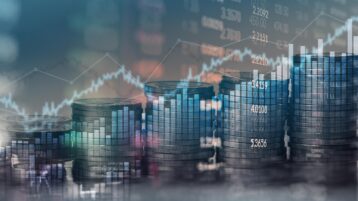Kim Parlee speaks with John Tobin, Managing Director and Portfolio Manager, Epoch Investment Partners, about why in an inflationary environment like we are in today, the concept of duration – a measurement of interest rate risk that is usually applied to bonds – is equally important to valuating equities.
Print Transcript
[MUSIC PLAYING]
- When we hear about duration, it's usually in the context when we're talking about bonds. And it's a way of measuring how bond prices are likely to change if interest rates move. My guest says-- who's coming up next-- that in the current environment, duration is very much relevant in talking about stocks and equities.
With more on this is John Tobin. He's a managing director and portfolio manager at Epic Investment Partners. He joins me from New York. John, great to have you with us. Let's just start with the basics. What is duration when you talk about equities?
- Sure. Well, Kim, thanks for having me. And you're absolutely right. Duration is normally something we think about when we're talking about bonds. It's a fixed income thing. And when you're thinking about a bond, you're going to get coupons every six months over the life of the bond.
And so duration is then a measure of how long you have to wait to get those coupons. Is it five years out in the future? 10 years, 30 years? What's the timing of that stream of coupons?
And duration, as you noted-- it's a measure of interest rate and risk. People often talk about bond math. And bond math is straightforward. It says that when rates go up, bond prices go down.
And bond math also says that the impact of an interest rate increase on long-term bonds is greater than it is for short-term bonds. And so the standard playbook for a bond portfolio manager is when rates are expected to go up, the smart thing to do is to shorten duration.
So what does all this have to do with equities? Well, the way we're looking at it is we're saying, if you look at equities instead of coupons, you can think of the dividends that you'd receive over time. Dividends, of course, are paid out of earnings. So really, what we're ultimately talking about when we apply this concept to equities is the timing and the amount of earnings that we get in the future.
Some companies, of course, just like some bonds, they have earnings that are far out in the future. And maybe little to no earnings and cash flow in the near-term future. And our point of view is that once you start to think of duration as a concept that applies to equities, it opens the door to thinking about duration as a risk factor.
The shares of a company with most of its cash flows out in the future is a long-duration equity. Its share price will react more to a given change in interest rates than the share price of a company that's generating earnings and cash flows and paying dividends today and in the immediate future. So hopefully, that helps you answer that question.
- It does. And John, maybe I'm oversimplifying, but I'm almost thinking, short-term duration equities, they're making money today. Long-term duration, maybe they're not making money today, but they'll make it tomorrow. And that's just what we have to manage through. And I think it's a great analogy.
- Yep.
- The concern, I know, that you were alluding to, is that companies, equities, stocks with long duration, could be facing the strongest headwinds as rates start to go up.
- That's right. It's our view that the interchanging environment that we're likely to face over the next couple of years is going to be very different from the one that we've experienced in the past couple of years. We've got global economies recovering from the pandemic. And even as growth is slowing down, we are still going to see above trend GDP growth across the developed world for the next couple of years.
And it's in response to that that we're seeing central banks around the world all moving to normalize policy and roll back some of the emergency steps that they put in place in response to the pandemic, tapering asset purchases, talking about when they might start to raise benchmark interest rates. And then, of course, inflation is turning out to be maybe not quite so transitory after all.
So, to us, these forces pretty persuasively convince us that rates are likely to be moving generally higher as we go forward from here. And this low interest rate environment that we've experienced in the past couple of years, which has been a very favorable tailwind for long-duration equities, is going to be turning into a valuation headwind for those stocks.
- I want to, if I can, bring in, John, a chart that you've brought in. And I think it's showing us how equities of different durations have fared historically as rates have gone up. Maybe you can just tell us a bit about what we're looking at.
- Sure. So what we're showing here-- we're looking at PE ratios. And we're going back a little bit in time, back to January of 2020. And what you see on this chart is the PE ratio for the MSCI World Index-- that's the top line-- and the MSCI World High Dividend Index-- that's the middle line-- and then, on the bottom, that line that you see, that's the yield on the 10-year US Treasury.
And what we highlighted, what we circled in this chart, is the recent episode, earlier this year, when the benchmark 10-year Treasury yield, it moved pretty decisively from about 1% in January to about 1.7% at the end of March, and misled, as we all know, to a rotation, a rotation away from some of the popular megacap tech and e-commerce stocks, toward stocks that were expected to benefit from economic recovery and reopening.
We were frequently referring to this as the rotation from growth to value. But I think what we're trying to suggest here, another way, another lens, another perspective on that, is it was a movement from long-duration stocks to short-duration stocks.
So as we look at this chart and look at that area that we've highlighted, what we're showing here is that there was a compression of the PE multiple that was much more pronounced in the broader market than it was for the MSCI World High Dividend Index. Now, that index, focusing on companies that are paying dividends, is structured to include stocks that are really short-duration stocks. And it really should capture, via proxy, for the universe of shorter duration stocks. So it highlights the difference in the impact of that rate change that we experienced earlier this year.
- John, I've only got about 45 seconds. I apologize for that. But I know you've got some names here, which you think fall in the category of short duration equities. These are stocks you hold in the Epic Global Shareholders' Yield Fund, which you manage. Give me, if I could, just 30 seconds on who they are and why.
- Sure. So I've got a couple of names where you hear-- it's a portfolio that focuses on companies with growing cash flows and paying an attractive growing dividends. We've got about 100 stocks in the portfolio that I would say could be used as an example of a short duration equity.
Maybe I'll talk about one in particular, Toyota. We own Toyota. It's one of the world's largest car makers, has a dominant Global Franchise, sells about nine million cars a year. $30 billion in cash flow from operations in the most recent 12-month period, $6 billion in dividends, and, by the way, about $2.5 billion was spent on share repurchase.
You could compare Toyota to Tesla. And that's almost the perfect short-duration, long-duration contrast. Tesla, revenues last year of just about $30 billion, EBITDA, a little under $5 billion. And that compares with Toyota, $250 billion in revenues and $35 billion in EBITDA.
So Tesla is obviously a story about a future where revenues and cash flows are hopefully much larger than they are currently.
- John, that's a great example. Appreciate you bringing it to us. Thanks so much for joining us.
- Thanks, Kim, for having me. Talk to you soon.
[MUSIC PLAYING]
- When we hear about duration, it's usually in the context when we're talking about bonds. And it's a way of measuring how bond prices are likely to change if interest rates move. My guest says-- who's coming up next-- that in the current environment, duration is very much relevant in talking about stocks and equities.
With more on this is John Tobin. He's a managing director and portfolio manager at Epic Investment Partners. He joins me from New York. John, great to have you with us. Let's just start with the basics. What is duration when you talk about equities?
- Sure. Well, Kim, thanks for having me. And you're absolutely right. Duration is normally something we think about when we're talking about bonds. It's a fixed income thing. And when you're thinking about a bond, you're going to get coupons every six months over the life of the bond.
And so duration is then a measure of how long you have to wait to get those coupons. Is it five years out in the future? 10 years, 30 years? What's the timing of that stream of coupons?
And duration, as you noted-- it's a measure of interest rate and risk. People often talk about bond math. And bond math is straightforward. It says that when rates go up, bond prices go down.
And bond math also says that the impact of an interest rate increase on long-term bonds is greater than it is for short-term bonds. And so the standard playbook for a bond portfolio manager is when rates are expected to go up, the smart thing to do is to shorten duration.
So what does all this have to do with equities? Well, the way we're looking at it is we're saying, if you look at equities instead of coupons, you can think of the dividends that you'd receive over time. Dividends, of course, are paid out of earnings. So really, what we're ultimately talking about when we apply this concept to equities is the timing and the amount of earnings that we get in the future.
Some companies, of course, just like some bonds, they have earnings that are far out in the future. And maybe little to no earnings and cash flow in the near-term future. And our point of view is that once you start to think of duration as a concept that applies to equities, it opens the door to thinking about duration as a risk factor.
The shares of a company with most of its cash flows out in the future is a long-duration equity. Its share price will react more to a given change in interest rates than the share price of a company that's generating earnings and cash flows and paying dividends today and in the immediate future. So hopefully, that helps you answer that question.
- It does. And John, maybe I'm oversimplifying, but I'm almost thinking, short-term duration equities, they're making money today. Long-term duration, maybe they're not making money today, but they'll make it tomorrow. And that's just what we have to manage through. And I think it's a great analogy.
- Yep.
- The concern, I know, that you were alluding to, is that companies, equities, stocks with long duration, could be facing the strongest headwinds as rates start to go up.
- That's right. It's our view that the interchanging environment that we're likely to face over the next couple of years is going to be very different from the one that we've experienced in the past couple of years. We've got global economies recovering from the pandemic. And even as growth is slowing down, we are still going to see above trend GDP growth across the developed world for the next couple of years.
And it's in response to that that we're seeing central banks around the world all moving to normalize policy and roll back some of the emergency steps that they put in place in response to the pandemic, tapering asset purchases, talking about when they might start to raise benchmark interest rates. And then, of course, inflation is turning out to be maybe not quite so transitory after all.
So, to us, these forces pretty persuasively convince us that rates are likely to be moving generally higher as we go forward from here. And this low interest rate environment that we've experienced in the past couple of years, which has been a very favorable tailwind for long-duration equities, is going to be turning into a valuation headwind for those stocks.
- I want to, if I can, bring in, John, a chart that you've brought in. And I think it's showing us how equities of different durations have fared historically as rates have gone up. Maybe you can just tell us a bit about what we're looking at.
- Sure. So what we're showing here-- we're looking at PE ratios. And we're going back a little bit in time, back to January of 2020. And what you see on this chart is the PE ratio for the MSCI World Index-- that's the top line-- and the MSCI World High Dividend Index-- that's the middle line-- and then, on the bottom, that line that you see, that's the yield on the 10-year US Treasury.
And what we highlighted, what we circled in this chart, is the recent episode, earlier this year, when the benchmark 10-year Treasury yield, it moved pretty decisively from about 1% in January to about 1.7% at the end of March, and misled, as we all know, to a rotation, a rotation away from some of the popular megacap tech and e-commerce stocks, toward stocks that were expected to benefit from economic recovery and reopening.
We were frequently referring to this as the rotation from growth to value. But I think what we're trying to suggest here, another way, another lens, another perspective on that, is it was a movement from long-duration stocks to short-duration stocks.
So as we look at this chart and look at that area that we've highlighted, what we're showing here is that there was a compression of the PE multiple that was much more pronounced in the broader market than it was for the MSCI World High Dividend Index. Now, that index, focusing on companies that are paying dividends, is structured to include stocks that are really short-duration stocks. And it really should capture, via proxy, for the universe of shorter duration stocks. So it highlights the difference in the impact of that rate change that we experienced earlier this year.
- John, I've only got about 45 seconds. I apologize for that. But I know you've got some names here, which you think fall in the category of short duration equities. These are stocks you hold in the Epic Global Shareholders' Yield Fund, which you manage. Give me, if I could, just 30 seconds on who they are and why.
- Sure. So I've got a couple of names where you hear-- it's a portfolio that focuses on companies with growing cash flows and paying an attractive growing dividends. We've got about 100 stocks in the portfolio that I would say could be used as an example of a short duration equity.
Maybe I'll talk about one in particular, Toyota. We own Toyota. It's one of the world's largest car makers, has a dominant Global Franchise, sells about nine million cars a year. $30 billion in cash flow from operations in the most recent 12-month period, $6 billion in dividends, and, by the way, about $2.5 billion was spent on share repurchase.
You could compare Toyota to Tesla. And that's almost the perfect short-duration, long-duration contrast. Tesla, revenues last year of just about $30 billion, EBITDA, a little under $5 billion. And that compares with Toyota, $250 billion in revenues and $35 billion in EBITDA.
So Tesla is obviously a story about a future where revenues and cash flows are hopefully much larger than they are currently.
- John, that's a great example. Appreciate you bringing it to us. Thanks so much for joining us.
- Thanks, Kim, for having me. Talk to you soon.
[MUSIC PLAYING]



























